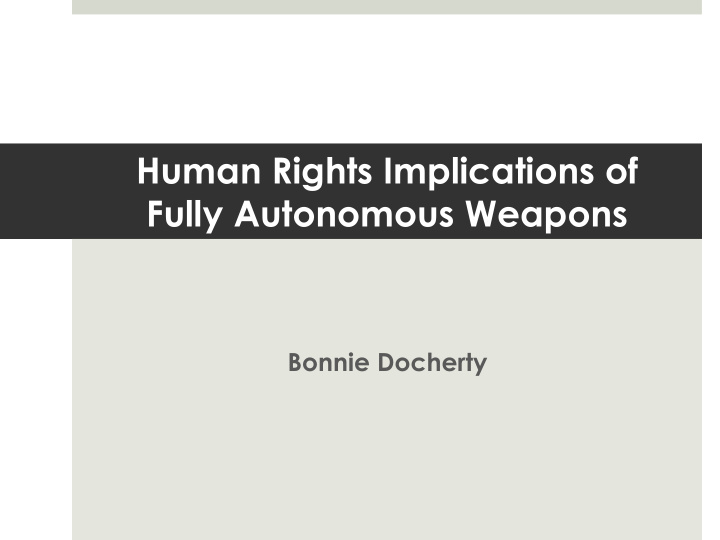



Human Rights Implications of Fully Autonomous Weapons Bonnie Docherty
Introduction CCW traditionally focused on international humanitarian law (IHL) But many states called for consideration of international human rights law (IHRL) Significant human rights implications of FAWs Human rights law relevant to FAWs Concerns raised under three core elements of IHRL: right to life, right to a remedy, and principle of dignity
Applicability of Human Rights IHRL applies during peace and armed conflict FAWs could be used for law enforcement as well as military operations Law enforcement operations include Local policing Use by state security forces to control opposition International counterterrorism efforts
Foundations of Human Rights Law Right to life “The supreme right” Prerequisite for all other human rights Right to a remedy Enforces all other rights Seeks to mitigate harm to victims Principle of human dignity Underlies all other rights From Universal Declaration of Human Rights and the International Covenant on Civil and Political Rights (ICCPR)
Right to Life Article 6 of the ICCPR “Every human being has the inherent right to life.” Non-derogable right Not absolute prohibition on killing “No one shall be arbitrarily deprived of his life.” Force must be Necessary, A last resort, and Proportional IHRL generally more stringent standards than IHL
Right to Life: Necessity Law Enforcement FAWs Could not be programmed Force must be “strictly to handle all scenarios necessary” and “exceptional” Lack human qualities that facilitate assessing whether Firearms used only to force is necessary defend oneself or others from “imminent threat of Attract different response death or serious injury” from individual than human officer would
Right to Life: Exhaustion of All Alternatives Lethal force must be last resort Firearms may only be used when “less extreme measures are insufficient” Harder for FAWs to ensure last resort Could not de- escalate situation by appealing to human’s reasons, emotions, or interests Perpetrator more likely to stand down for human officer than machine
Right to Life: Proportionality Law Enforcement FAWs Force must be proportional Lack human judgment to to threat and minimize balance response with threat harm or handle unforeseen circumstances Officers should take into account perpetrator’s Lack compassion, which is background, mental state, safeguard against and demands disproportionate force
Right to Life in Armed Conflict IHRL applies during armed conflict as well as law enforcement situations Lex specialis: In situations of armed conflict, IHL used to interpret the definition of arbitrary killing FAWs could be prone to acting unlawfully in armed conflict for similar reasons as in law enforcement
Right to a Remedy ICCPR obliges states parties to “ensure that any person whose rights or freedoms … are violated shall have an effective remedy.” States must investigate, prosecute, and punish serious violations of IHRL States should provide reparations to victims States should enforce civil judgments
Right to a Remedy Remedy and Accountability Right to remedy promotes personal accountability Deters future violations Provides retribution to victims of past violations Accountability gap for FAWs in law enforcement and armed conflict All parties escape liability under existing law
Right to a Remedy: Criminal Law Human could be held liable for intentionally misusing robot to commit a crime Concern when FAW acts unforeseeably due to no meaningful human control Unfair and, under existing law, impossible to hold human liable for actions neither knew about nor could prevent Hurdle under direct and command responsibility
Right to a Remedy: Civil Law Barriers to domestic civil suits Immunity for government and government contractors Evidentiary hurdles in product liability cases against programmer or manufacturer
Human Dignity Machines could not comprehend or respect value of human life Allowing FAWs to determine when to take life could undermine human dignity “Machines lack morality and mortality, and should as a result not have life and death powers over humans.” - Christof Heyns
Links across Disciplines Right to life and use of force IHL similarly lays out restrictions on use of force Right to a remedy and accountability Accountability also issue under IHL, international criminal law, and domestic civil law Human dignity and ethics Many question morality of machines making life-and-death determinations
Conclusion Human rights implications of FAWs compound other threats Cumulative concerns could be resolved with prohibition of FAWs Threat of harm argues for precautionary measures CCW states parties should Follow precedent of Blinding Lasers Protocol Preempt development of revolutionary yet dangerous weapons technology
Recommend
More recommend